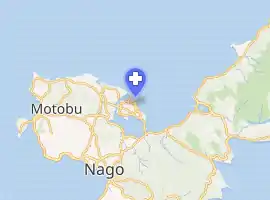Okinawa Airakuen Sanatorium
The Okinawa Airakuen Sanatorium (or National Sanatorium Okinawa Airakuen) is a sanatorium for current or former leprosy patients in Nago, Okinawa, Japan that was established in 1938.
| Okinawa Airakuen Sanatorium | |
|---|---|

| |
| Geography | |
| Location | 1192 Sumuide, Nago, Okinawa, Japan |
| Organisation | |
| Care system | HealthCare of those who had leprosy |
| Type | National hospital run by Ministry of Health, Labour and Welfare (Japan) |
| Services | |
| Beds | 423 (Japanese health and medical law) and 309 (in-patients) |
| History | |
| Opened | 1938 |
| Links | |
| Website | http://www.hosp.go.jp/~airakuen/ |
| Lists | Hospitals in Japan |
History
History before the sanatorium
Major events
On November 10, 1938, the sanatorium first opened as the Okinawa Prefectural Kunigami Airakuen Sanatorium. In April 1941 it was renamed as the National Kunigami Airakuen Sanatorium.
- April 25, 1946: operated by United States Military Government
- April 1, 1952: transferred to the newly created Ryukyu Government
- August 26, 1961: Leprosy Prevention Law is promulgated in Okinawa
- May 15, 1972: Okinawa returned to Japan. Renamed the National Sanatorium Okinawa Airakuen.
- April 1, 1996: Leprosy Prevention Law is abolished
World War II
Nearly 400 new leprosy patients were admitted by the Japanese army in September 1944 for a total of around 913 patients. The high population led to food shortages, and housing conditions were deplorable. When the Battle of Okinawa began in April 1945, the sanatorium director Hiroshi Hayata allowed patients to leave and avoid the battle. By the end of April, US forces had occupied the sanatorium.
After World War II
- August 1945: the director of the army hospital visits the sanatorium.
- March 8, 1946: the Yagaji Sanatorium on Yagaji Island becomes the restricted area
- 1949: Dr. V. Scorebrand visits the sanatorium and tries to use promin.
- July 1953: Dr. Doull visits Okinawa for two months and reports various recommendations concerning leprosy.
- March 1951: Okinawa 'Save the Leprosy Patients' Association is founded
- February 1954: the Jichikai (patients' association) for Airakuen founds the Tomonokai association for those discharged from Airakuen and Miyako Nanseien Sanatoriums.
- February 1960: outpatient clinic is started in Naha. Similar clinics are later built on the islands of Ishigakijima and Miyakojima
- March 1957: the Japanese Government begins sending leprosy specialists to two Okinawan sanatoriums.
- 1967: Okinawan schoolchildren surveys begin
- April 1996: Leprosy Prevention Law of 1953 is abolished
- July 1998: trial for compensation begins
- May 11, 2001: previous Leprosy Prevention Law is ruled unconstitutional during the trial
- May 25, 2001: trial for compensation is decided. 8 to 14 million yen is given to patients depending on the duration of unconstitutional period
See also
Notes
- Fukken eno Jitsugetsu (2001) Koyo Shuppansha Tokyo p.374
- 2009,1,5
References
- The transitions of the leprosy policy (1999) Kazuo Saikawa, Okinawa Leprosy Prevention Association. in Japanese.
External links
- Airakuen Sanatorium HP, in Japanese